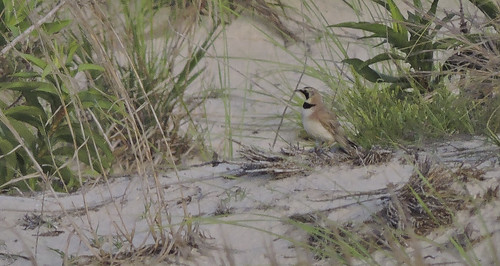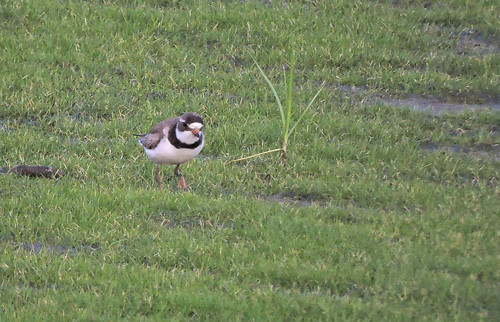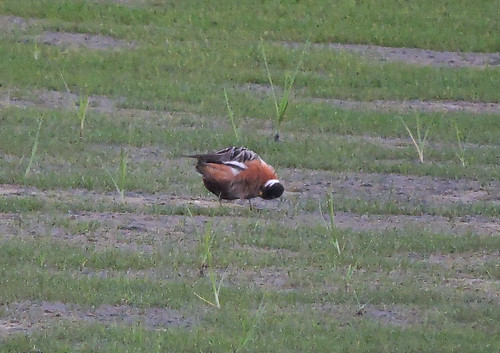That title got your attention, didn't it?
I say "The Watchamacallit Bird" because to many people, this bird's name is really hard to pronounce. What everyone can agree about, though, is that a week ago, a RED PHALAROPE turned up at Jones Beach, which is really not where it's supposed to be at all. Luckily, the bird stuck around for a while, and I went to chase it eight days after it first showed up.
I knew I was in for a good evening (you get to the beach really early or really late so you don't have to pay) when the first bird I saw upon pulling into the parking lot was a small gathering of Horned Larks chasing each other around the dunes. As you may recall, I spent a lot of time at Jones Beach in the winter trying in vain to see just one Horned Lark. Seeing them in full breeding splendor, calling and engaging in aerial duels was quite a sight.
We (my parents and I) set off into the dunes, discovered that we were going in precisely the wrong direction, came back to the parking lot, and set off in the right direction.
We did, in fact, find the ponds where the bird had been seen. On these ponds, there were many shorebirds. The water had mostly dried up, leaving expanses of flats, which were now covered liberally in scores of Least and Semipalmated Sandpipers, with Killdeer running to and fro and Semipalmated Plovers tapping the ground with their feet to lure insects to the surface. Overhead, Short-billed Dowitchers wheeled into a spiraling descent to the flats.
I say "The Watchamacallit Bird" because to many people, this bird's name is really hard to pronounce. What everyone can agree about, though, is that a week ago, a RED PHALAROPE turned up at Jones Beach, which is really not where it's supposed to be at all. Luckily, the bird stuck around for a while, and I went to chase it eight days after it first showed up.
I knew I was in for a good evening (you get to the beach really early or really late so you don't have to pay) when the first bird I saw upon pulling into the parking lot was a small gathering of Horned Larks chasing each other around the dunes. As you may recall, I spent a lot of time at Jones Beach in the winter trying in vain to see just one Horned Lark. Seeing them in full breeding splendor, calling and engaging in aerial duels was quite a sight.
 |
| Horned Lark takes a break from fighting |
We (my parents and I) set off into the dunes, discovered that we were going in precisely the wrong direction, came back to the parking lot, and set off in the right direction.
We did, in fact, find the ponds where the bird had been seen. On these ponds, there were many shorebirds. The water had mostly dried up, leaving expanses of flats, which were now covered liberally in scores of Least and Semipalmated Sandpipers, with Killdeer running to and fro and Semipalmated Plovers tapping the ground with their feet to lure insects to the surface. Overhead, Short-billed Dowitchers wheeled into a spiraling descent to the flats.
 |
| Semipalmated Plover |
Common Terns were flying overhead, and with them were their smaller, rare counterparts, the Least Terns. With their white wings flashing over our heads, we walked on, checking each mudflat for a red bird with a yellow bill.
Finally, we reached a photography blind overlooking the pond where the phalarope had been discovered. I scanned it quickly with binoculars, and in the dimming light, found a rusty red bird with all the distinguishing characteristics of it's species. This small bird was, in fact, the RED PHALAROPE that had caused such stir among birders in New York.
Truly, it's fame was well-earned. It was a breeding-plumaged female, meaning it was really beautiful. It's overall color was a bright orangish crimson, but close inspection with a scope revealed a black back streaked with white and a bright white patch on the cheek, accented by a bright yellow bill with which it probed in the mud. I hadn't the faintest idea what the bird was doing there, but it seemed perfectly at home, despite standing out visually from the browns of the other shorebirds. This bird's name, by the way, is pronounced FAL-A-ROPE. I have no idea how it got that name, but somehow it seemed to fit.
We decided to finish up the day at the Coast Guard Station. Unfortunately it was high tide, but a flock of Sanderlings scurried back and forth, chasing the waves. Here's a tip: Sanderlings have no hind toe, so if you see a Sanderling with a hind toe, start to reconsider your ID. Using this method, I pulled two Semipalmated Sandpipers out of the flock.
The Sanderlings soon departed, as did the sun. It was a fine way to end the day, as it was necessary to leave the American Oystercatchers and Laughing Gulls that lingered and head back home.
But shorebird season is just beginning, and you can bet there's more to come.
 |
| RED PHALAROPE! |
We decided to finish up the day at the Coast Guard Station. Unfortunately it was high tide, but a flock of Sanderlings scurried back and forth, chasing the waves. Here's a tip: Sanderlings have no hind toe, so if you see a Sanderling with a hind toe, start to reconsider your ID. Using this method, I pulled two Semipalmated Sandpipers out of the flock.
The Sanderlings soon departed, as did the sun. It was a fine way to end the day, as it was necessary to leave the American Oystercatchers and Laughing Gulls that lingered and head back home.
But shorebird season is just beginning, and you can bet there's more to come.